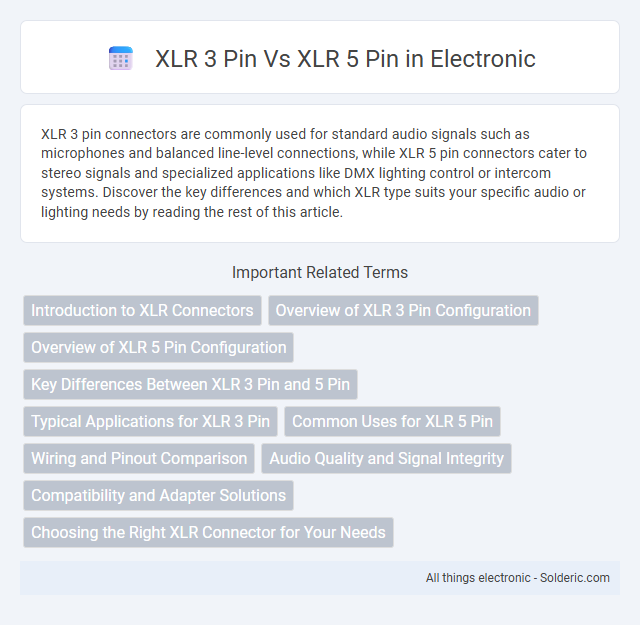XLR 3 pin connectors are commonly used for standard audio signals such as microphones and balanced line-level connections, while XLR 5 pin connectors cater to stereo signals and specialized applications like DMX lighting control or intercom systems. Discover the key differences and which XLR type suits your specific audio or lighting needs by reading the rest of this article.
Comparison Table
| Feature | XLR 3 Pin | XLR 5 Pin |
|---|---|---|
| Pin Count | 3 pins | 5 pins |
| Typical Usage | Balanced audio signals, microphones | Intercom systems, DMX lighting control, stereo audio |
| Signal Types | Audio: positive, negative, ground | Audio plus additional control or power signals |
| Compatibility | Standard for most audio equipment | Specialized devices requiring extra pins |
| Connector Size | Compact | Slightly larger due to extra pins |
| Common Applications | Microphones, mixers, audio interfaces | Intercoms, DMX lighting consoles, professional audio setups |
| Wiring Complexity | Simple, 3-wire | More complex, 5-wire |
Introduction to XLR Connectors
XLR connectors are essential components in professional audio and lighting setups, with the 3-pin and 5-pin variants serving distinct purposes. The XLR 3-pin connector is primarily used for balanced audio signals, making it a standard choice for microphones and audio equipment. Your choice between XLR 3-pin and 5-pin depends on whether you need simple audio transmission or additional pins for applications like DMX lighting control or intercom systems.
Overview of XLR 3 Pin Configuration
XLR 3 Pin configuration is the industry standard for balanced audio connections, primarily used for microphones and professional audio equipment, featuring three pins dedicated to ground, positive, and negative signals. This design minimizes electromagnetic interference and ensures clear, noise-free audio transmission. Understanding the 3 Pin setup allows you to optimize audio connectivity and compatibility across a wide range of devices.
Overview of XLR 5 Pin Configuration
XLR 5 Pin connectors feature five contact points arranged in a circular pattern, designed to transmit balanced audio signals alongside additional data or power connections. This configuration supports complex audio setups such as DMX lighting control or stereo microphone inputs, offering greater versatility compared to the standard XLR 3 Pin. Understanding the pinout is essential for ensuring compatibility with your professional audio and stage equipment.
Key Differences Between XLR 3 Pin and 5 Pin
XLR 3 Pin connectors are primarily designed for balanced audio signals, commonly used for microphones and standard audio equipment. XLR 5 Pin connectors provide two additional pins that support stereo audio signals or intercom systems, enabling more complex audio configurations and power transmission. Understanding your audio setup's requirements helps determine whether the simpler 3 Pin or the more versatile 5 Pin XLR best suits your needs.
Typical Applications for XLR 3 Pin
XLR 3 Pin connectors are primarily used in professional audio applications such as microphones, mixers, and PA systems due to their reliable balanced audio connection that reduces noise and interference. These connectors are standard in live sound, broadcasting, and recording studios, making them the preferred choice for transmitting mono audio signals. Their simplicity and durability make them suitable for connecting a wide range of audio equipment where high-quality sound integrity is essential.
Common Uses for XLR 5 Pin
XLR 5 pin connectors are commonly used in professional audio equipment to support stereo or dual-mono balanced audio signals, enabling more complex sound setups such as intercom systems and lighting control interfaces. They are favored in settings requiring multiple signal paths within a single cable, like DMX512 lighting control and multi-channel audio transmission. This expanded pin configuration allows greater versatility compared to the standard XLR 3 pin, which is primarily designed for balanced mono audio signals.
Wiring and Pinout Comparison
XLR 3 Pin connectors feature three wires: pin 1 for ground, pin 2 for positive (hot), and pin 3 for negative (cold), making them standard for balanced audio signals in microphones and audio equipment. In contrast, XLR 5 Pin connectors include two additional pins (pins 4 and 5), commonly used for stereo audio signals or DC power distribution alongside audio, offering greater versatility in complex setups. The wiring of XLR 5 Pin cables varies depending on application, with pin assignments differing for intercom headsets, lighting control, or audio, which requires careful attention to compatibility when replacing or integrating cables.
Audio Quality and Signal Integrity
XLR 3 Pin connectors are widely used for balanced audio signals, ensuring excellent audio quality by minimizing noise and interference in microphone and line-level connections. XLR 5 Pin connectors offer additional channels or signals, often employed in more complex audio setups like DMX lighting control or stereo microphone systems, potentially enhancing signal integrity where multiple audio paths are necessary. Your choice between XLR 3 Pin and 5 Pin should consider the required channel count and the specific application to maintain optimal audio quality and signal reliability.
Compatibility and Adapter Solutions
XLR 3 Pin connectors are widely used for standard microphone and audio line-level signals, ensuring broad compatibility across most professional audio equipment. XLR 5 Pin connectors are primarily designed for stereo microphones, intercom headsets, or DMX lighting control, requiring specific devices that support the additional pins. You can use adapter solutions to connect XLR 3 Pin cables to 5 Pin ports, but these adapters may limit functionality by carrying only mono signals or requiring custom wiring configurations.
Choosing the Right XLR Connector for Your Needs
XLR 3 Pin connectors are ideal for standard balanced audio signals, commonly used in microphones and professional audio equipment due to their simplicity and widespread compatibility. XLR 5 Pin connectors provide additional pins for stereo audio channels or intercom systems, making them suitable for more complex setups requiring extra signal paths. Selecting the right XLR connector depends on your specific application, signal requirements, and the equipment you intend to interface with.
XLR 3 Pin vs XLR 5 Pin Infographic

 solderic.com
solderic.com